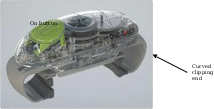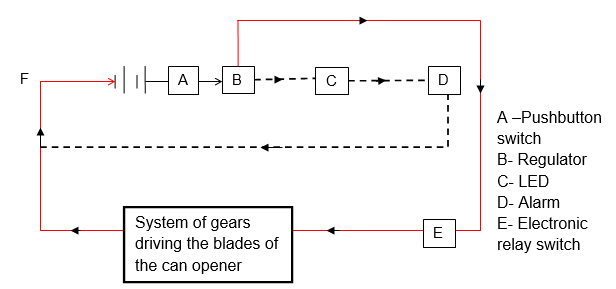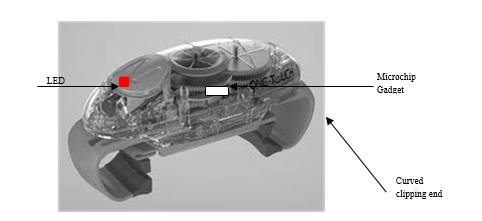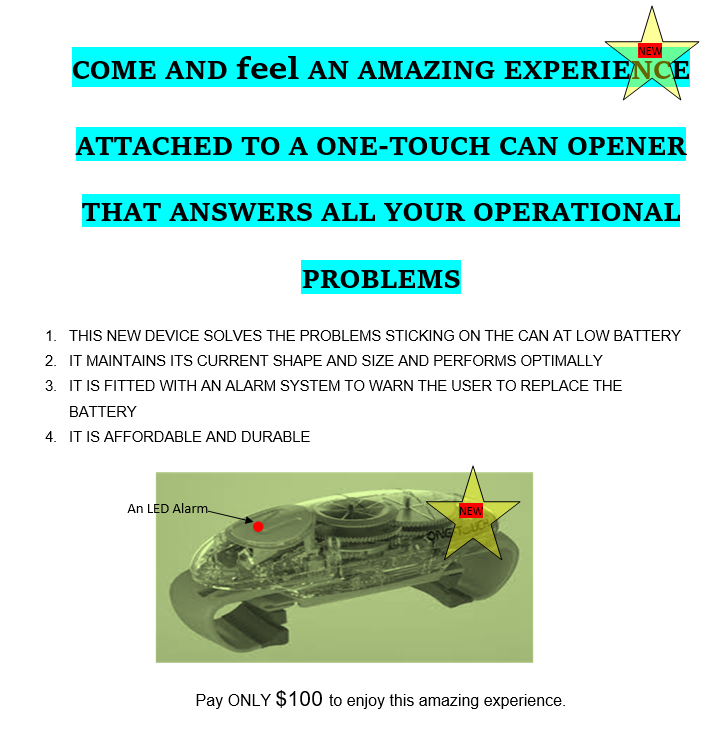When Peter Durand invented the canning technology in the year 1810, many viewed this as a major milestone in the science of food preservation (Warner 67). Very few people would reckon the difficulties presented by the same when trying to access the contents that were inside the can. To this end, it took the efforts of Ezra Warner to design a tool, a can opener, in the year 1858 to solve this problem (Bunker 98). This marked the beginning of a major evolution in the can opener designs that come as either manual or electrical-based. Today, very many can openers exist, incorporating special features that enhance their performance (Osterhoudt 45).
One such can opener is a ‘One Touch Can Opener’ which is electrically powered to achieve its function. The recent innovation in this type of can opener seemed to have solved the main problem that its users were experiencing while operating it. In essence, the problem that was the application of force (equivalent to 50 kg) by a person using it is long gone thanks to the changes in design (see the figure below) (Bunch 56).

The initial design was flat-shaped, requiring the application of pressure by the user to enhance the opening. This current design is curved, and as such can clip a can while cutting the can open without the application of pressure. However, the current problem does not emanate from the shape of the gadget but the mechanical cum electrical part.
An important feature of this gadget is that it is motorized by AA batteries (two), taking approximately 25 seconds to accomplish a task (Chang 10). As such, the batteries need replacement after they have been exhausted (Theriault 102). The main problem experienced by users is that these gadgets get stuck on the can when the batteries are exhausted, and can even take up to 10 minutes before removing it from the can. With this problem at hand, I reckon that a design that incorporates an in-built warning system indicating ‘low battery’ once the start button is switched on would address the problem (Lyman 98).
Furthermore, this warning would come a few minutes before the gadget goes off and it will be accompanied by an alarm, alerting the user immediately. It is important to set the alarm and the indicator a few minutes before the battery is flat since the gadget takes only 25 seconds to complete its task (Gordon 33). To this end, the gadget will complete its current task, giving the user ample time to replace the batteries before the next task. Also, this system of the alarm would be connected to the gears driving the blade such that it cuts the current, ceasing to perform the next task once the switch is on once again. At this juncture, the indicator will indicate ‘low batter’ alerting the user to replace the battery once more before the next task.
From the description of how the re-designed gadget would look like, the area that needs improvement is the electrical part. For the aforementioned modifications, the gadget would be fitted with electronic components including an LED indicator indicating ‘low battery,’ an alarm, a pushbutton switch, a system of diodes and resistors (regulator), and an electronic relay switch to cut the current supplying the gears at the low current level.
As such, one would wonder how these gadgets will fit in the design without increasing the size of the device. In essence, with the advent of semiconductors, this drawback was addressed. To this end, a seemingly large component on paper can be fitted in a small circuit board without necessarily increasing the size of the device. A typical circuit board operating this system would appear as below (figure 2).

With these modifications, upon switching on the device (A), the flow of current when the battery voltage is above the minimum level will be through ABEF. In this case, the regulator cuts the current flow towards C at high currents. As such, the LED will not indicate “low battery,” and the alarm will not go off. When the cell goes below the minimum voltage, the regulator will allow current to flow through routs ABCDF and ABEF. As such, the LED will indicate ‘low battery’ and the alarm will go off alerting the user. Note that the electronic relay will be activated by very small currents.
To this end, when the battery is not replaced and then the device is switched on again, a lot of power is lost prompting the electronic relay to cut off the power supply serving the gears. As such, the gears would not run, and the current flowing through gadgets C and D would warn the user to replace the battery. With this gadget, the problem would be solved. One advantage of contemporary electronic devices is that they are small-like microchips that consume less space. To this end, this device would not cause major changes in the design of the machine (see figure 3 below), consuming the same area as before (Bodle 46).

My re-designed device incorporates the gadget above (figure 2) devoid of making considerable changes in the device’s design. This is due to the gadget’s small size. With regards to functions, my device will alert the user when the battery is low and cautions the user on further usage by ceasing to function before the battery is replaced. With this, the problem of getting stuck on the can would be addressed.
With regards to marketing my product to potential clients, the advert below would work. Importantly, my target markets are for general home use as well as tourists. These are the most appropriate market segments that consume canned products (Painter 23).

Works Cited
Bodle, Walter. “Can opening and knife sharpening device.” Journal of mechanical engineers 45.5 (2006): 45-46. Print.
Bunch, Bryan. The history of science and technology. Denver: CO Press, 2009. Print.
Bunker, Charles. Can opener. Denver: CO Press, 2007. Print.
Chang, Kun-Jen. Side cutting can opener with a double grip. Boston: Havard Engineering School Press, 1999. Print.
Gordon, Robertson. Food packaging. San Francisco, CA: Benjamin Cummings, 2008. Print.
Lyman, Willian. Improvement in can openers. Denver: CO Press, 2009. Print.
Osterhoudt, Jude. “Improved Method of Opening Tin Cans.” Journal of mechanical engineers 78.5 (2006): 45-46. Print.
Painter, William. The best advertisement. Cambridge: Cambridge University Press, 2005. Print.
Theriault, Mario. Great Maritme Inventions. Ambler, PA: Lippincott Williams & Wilkins, 2004. Print.
Warner, Ezra. Can opener. New York, NY: New York University Press, 2008. Print.